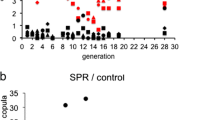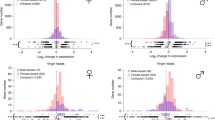Abstract
Mating inDrosophila is precisely characterized by an exponential phase based on second-order kinetics coupled with an initial lag phase based on zeroth-order kinetics. In this model, the two separate kinetic phases are quantified by separate parameters. Three genetically distinct lines ofDrosophila simulans differing in male and female mating propensities (measured by the relative frequencies of animals mating after a fixed interval of time) also differed sharply in both parameters of mating kinetics. One line was highly outcrossed and the other two, derivatives of the first, had been subjected to genetic drift. The lines and their F1 hybrids were studied in “no-choice” mating tests with a “control line” to determine the two parameters describing mating kinetics and were observed in pair matings to measure four courtship traits. The two parameters of mating kinetics (L, which describes the lag phase, andK, which describes the exponential phase) and the mean percentage mating varied widely across the nine types, in both sexes. The logarithm ofL was linearly related to the percentage mating (r 2=0.732);L andK were not significantly correlated. Among female genotypes, only one courtship trait varied significantly—the latency from coconfinement of female and male to initiation of courtship; among male genotypes, the duration of the two wing displays, scissor and vibrate, varied significantly. LogK was significantly (P<0.01) correlated with the latency to courtship (r=−0.626) and with the duration of two components, orient (r=0.701) and scissor (r=0.698), whereas logL and percentage mating were not significantly correlated with components of courtship. There was evidence of inbreeding depression forL, but not forK, in both sexes of the drift lines.
Similar content being viewed by others
References
Bastock, M., and Manning, A. (1956). The courtship ofDrosophila melanogaster.Behavior 8:85–109.
Connolly, K., Burnet, B., Kearney, M., and Eastwood, L. (1973). Mating speed and courtship behaviour of inbred strains ofDrosophila melanogaster.Behaviour 48:61–74.
Cook, R. M. (1973). Physiological factors in the courtship processing ofD. melanogaster.J. Insect Physiol. 19:387–406.
Crossley, S., and McDonald, J. (1979). The stability ofDrosophila melanogaster courtship across matings.Anim. Behav. 27:1041–1047.
Dewsbury, D. A., Oglesby, J. M., Shea, S. L., and Connor, J. L. (1979). Inbreeding and copulatory behavior in house mice: A further consideration.Behav. Genet. 9:151–163.
Dowse, H., Ringo, J., and Barton, K. (1984). A model describing the kinetics of mating inDrosophila.J. Theor. Biol. 121:173–183.
Elens, A. A., and Wattiaux, J. M. (1964). Direct observation of sexual isolation.Dros. Info. Serv. 39:118–119.
Ewing, A. W. (1964). The influence of wing area on the courtship behaviour ofDrosophila melanogaster.Anim. Behav. 12:316–319.
Falconer, D. S. (1981).Introduction to Quantitative Genetics, 2nd ed., Ronald Press, New York.
Fulker, D. (1966). Mating speed in maleDrosophila melanogaster: A psychogenetic analysis.Science 153:203–205.
Goodnight, J. H. (1982). The STEPWISE procedure. In Ray A. A. (ed.),SAS User's Guide: Statistics, SAS Institute, Inc., Cary, N. C.
Graur, D., and Wool, D. (1982). Dynamics and genetics of mating behavior inTribolium castaneum (Coleoptera: Tenebrionidae).Behav. Genet. 12:161–179.
Jacobs, M. E. (1978). The influence of beta-alanine on mating and territorialism inDrosophila melanogaster.Behav. Genet. 8:487–502.
Jallon, J.-M. (1984). A few chemical words exchanged byDrosophila during courtship and mating.Behav. Genet. 14:441–478.
Manning, A. (1961). The effects of artificial selection for mating speed inDrosophila melanogaster.Anim. Behav. 9:82–92.
Ringo, J. M. (1987). The effect of successive founder events on mating propensity ofDrosophila. In Huttel, M. (ed.),Evolutionary Genetics of Invertebrate Behavior, Plenum, New York.
Siegel, R. W., and Hall, J. C. (1979). Conditioned responses in courtship behavior of normal and mutantDrosophila.Proc. Natl. Acad. Sci. USA 76:3430–3434.
Siegel, R. W., Hall, J. C., Gailey, D. A., and Kyriacou, C. P. (1984). Genetic elements of courtship inDrosophila: Mosaics and learning mutants.Behav. Genet. 14:383–410.
Sokal, R. R., and Rohlf, F. J. (1981).Biometry, 2nd ed., W. H. Freeman, San Francisco.
Speiss, E. B. (1970). Mating propensity and its genetic basis inDrosophila. In Hecht, M. K., and Stene, M. C. (eds.)Essays in Evolution and Genetics in Honor of Theodosius Dobyhansky, North-Holland, Amsterdam.
Spieth, H. T. (1974). Courtship behavior inDrosophila.Annu. Rev. Entomol. 19:385–405.
Spieth, H. T., and Ringo, J. M. (1983). Mating behavior and sexual isolation inDrosophila. In Ashburner, M., Carson, H. L., and Thompson, J. N., Jr. (eds.),The Genetics and Biology of Drosophila, Vol. 3c, Academic Press, New York
Taylor, C. E. (1975). Differences in mating propensities: Some models for examining the genetic consequences.Behav. Genet. 5:381–393.
Tompkins, L. (1984). Genetic analysis of sex appeal inDrosophila.Behav. Genet. 14:411–440.
Wood, D. F., and Ringo, J. M. (1980). Male mating discrimination inDrosophila melanogaster, Drosophila simulans, and their hybrids.Evolution 34:320–329.
Wood, D. F., and Ringo, J. M. (1982). Artificial selection for altered male wing display inDrosophila simulans.Behav. Genet. 12:449–458.
Wood, D. F., Ringo, J. M., and Johnson, L. L. (1980). Analysis of courtship sequences of the hybrids betweenDrosophila melanogaster andDrosophila simulans.Behav. Genet. 10:459–466.
Author information
Authors and Affiliations
Additional information
The research was supported in part by NSF Grant DEB 7903866 and a grant from the University of Maine and by the Computing Center of the University of Maine.
Rights and permissions
About this article
Cite this article
Ringo, J.M., Dowse, H.B. & Barton, K.M. Courtship behavior and the kinetics of mating in three lines ofDrosophila simulans and their hybrids. Behav Genet 17, 141–154 (1987). https://doi.org/10.1007/BF01065993
Received:
Accepted:
Issue Date:
DOI: https://doi.org/10.1007/BF01065993




